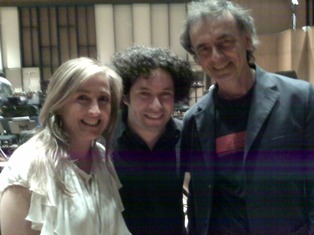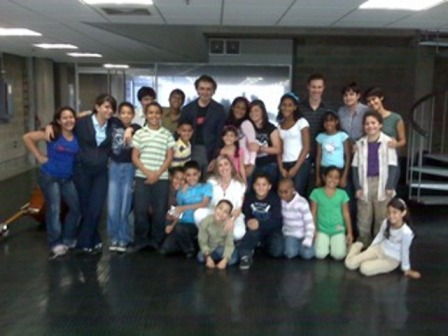Click here for Part Three
Caracas,
April 12-13, 2010
This will be the start of “The Week That Was!” for us and this wonderful, colorful band of children. If I didn’t know through years of composing symphonic music that creativity can indeed be given a boost in restricted, unknown and time-intensive circumstances, I would say this could not be done, even attempted.
But Richard Mannoia and I, together with Dani Bedoni of El Sistema, are determined to accomplish two major goals this week: First, to provide these children with warmth and empowerment, and a chance to realize their own creativity. Second, in taking their artistic efforts truly seriously, to give El Sistema and the wider musical world even the slightest and most fleeting glimpse of what children’s art (and therefore great art) might sound like in the future.
Children, show us the way!
That said, no one can assume that the way will be easy. What I so love about this project, is the fact that El Sistema, with its spectacular successes and established results worldwide, has nonetheless not forgotten its experimental roots! From its very top: from Maestro José Antonio Abreu, from Gustavo Dudamel, to all its administrators, staff and students, I feel an abiding sense of support, interest, and above all patience.
Monday, the 12th of April. We arrive a bit late, and the children, mostly from the Montalban district, are even later. They must endure a long bus ride after their days at school, and even Dani’s organizational genius cannot change the famous and unpredictable traffic jams of Caracas. As prepared as we are, we are constantly altering plans, adapting, experimenting.
Even more children are here today!
They are energetic, eager and somewhat disoriented as well. It appears that they have done quite a bit of work over the weekend, contrary to our expectations. With this many children, even splitting them up into smaller groups, we are forced to rely on their notational skills to some extent. That they have notational skills at this age is a blessing and a curse. (Well, okay, a bit of a “problem”): “literacy” has in many cases caused them to channel their ideas into pre-defined paths. Even our constant encouragement to graphically express their free ideas, to think of their instruments as magically empowered, does not always get through. We are getting lots of white-key pitches and quarter-note rhythms. As before, the way around this is to get them to sing, tap, hum, dance what they’ve written, and to take that as the urtext, not what they self-edit in their notation. But this takes time.
Both Dani and a young composer named Pedro Bernardez have already arrived at a deep understanding of this creative process, take delight in it, are able to work somewhat independently with the kids, and this is truly a godsend. Rosa Contreras, a violinist-composer, is also very helpful. Still, the process takes time. How could it not? Is there enough time? Will the arrival of Diana Arismendi, the head composer here, facilitate the process?
We need so much! It’s called, well: infrastructure: we need scribes, a working xerox machine, more classrooms, keyboards, time to work on an individual basis, composer/teachers, professional level musicians, (especially a percussionist today!), a blackboard of some sort, firm rehearsal times, proofreaders, and Diana Arismendi!
One exercise I introduce to the general class is a form that I feel liberates, rather than limits kids: theme and variations. At least we’ve had success with this form in the past. We never demonstrate the Mozart Ah Vous drai-je, Maman , variations on Twinkle, Twinkle Little Star, but rather merely mention the idea of “keeping something and changing something, especially the feeling,” which seems to give them real freedom, yet a little island from which to start, as some are intimidated by the blank page.
But whose theme? So, we decide to vote. I ask for four volunteers to submit a theme of their own, and immediately get fifteen! A theme by Luis Pichardo eventually wins the final round, with several other strong contenders. A team spirit, rather than merely competitive infighting seems to pervade. Would that adults could be so mature.
Nine students express a desire to form a theme-and-variations work. Will they follow through on this? Well, what matters more is that they feel this gives them a place from which to start.
The children do like to make fun of my grammatical errors, which slows things down, but Dani is always there to help. I laugh often, and tell them that the important thing is not my speech but their music. We even have them demonstrate the rhythm of their speech and physical movements.
A big job, but a good class today.
At night, we attend a rehearsal of the Simón Bolívar Orchestra, again conducted by Gustavo, who leads them through the Cantata Criolla, written by the Venezuelan composer Antonio Estevez in 1957. Again, we are amazed by the ensemble, technical precision and especially the rhythmic surety. I look at the score and realize how severely most North American Orchestras would be challenged by it: long passages written in 15/16 – 2/8 – 17/16 – 3/8 time, and executed with unanimity and a convincing “groove” by entire sections. Can you imagine this with most orchestras?
And still, after the rehearsal, Gustavo again urges us in giving importance to the Young Composers’ project, which we are now beginning to refer to as “JoCoVen,” a local-type of acronym for “Jóvenes Compositores Venezolanos.”
Just another day of marvels and hard work.
–Jon Deak
Click here for Part Five
***************************************************************************************************************
Jon Deak, born in the sand dunes of Indiana of East European parents, is a Composer, Contrabassist, and Educational pioneer. Educated at Oberlin College, the Julliard School, the Conservatorio di Santa Cecilia (Rome) and the University of Illinois, he joined the New York Philharmonic and served as its Associate Principal Bassist for many years, while continuing his professional composing, and studying with Pierre Boulez and Leonard Bernstein. During this time he also introduced ground-breaking performance techniques for the Contrabass, and in his orchestral writing, working with major orchestras across the country.
From 1994 – 97 he served as Composer In Residence (sponsored by Meet the Composer) with the Colorado Symphony under Marin Alsop, which is where he initiated the public school program now called The Very Young Composers (VYC).
With support from the New York Philharmonic and others, the VYC has grown steadily, winning a national award for excellence in 2004. The program has been introduced in Shanghai, Tokyo, and now in Venezuela, besides serving hundreds of children in eleven New York area Public Schools and such places as New England and Eagle County, Colorado. The New York Philharmonic has premiered 42 works for children, fully orchestrated by the children themselves, mostly under the ages of 13, as well as hundreds of chamber works in the public schools and libraries.

Daniela Bedoni, Guztavo Dudamel, and Jon Deak

Daniela Bedoni, Richard Mannoia, and Jon Deak with children from El Sistema
 blog | AJBlog Central | Contact me | Advertise | Follow me:
blog | AJBlog Central | Contact me | Advertise | Follow me: 

